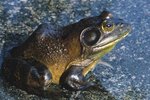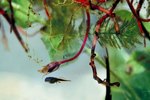
Polliwog and tadpole are different words for the same thing. Both words refer to the larval stage of both frogs and toads. Although experts can differentiate many tadpoles by species, all have gills, eyes, a tiny mouth, and a fin-like tail. The metamorphosis from this larval form swimming in a watery environment to adult amphibian with legs and lungs adapted to life out of water is a journey fraught with danger. Among the hazards are numerous predators of various types, and uncertain environmental conditions. Few tadpoles will survive to become adult frogs or toads.
The Egg Comes First
The mother frog or toad lays her eggs in or very close to water. Frogs generally lay eggs in clusters, while toad eggs are laid in chains. Sometimes the frog mother will lay her eggs above the water, on a branch or leaf, to protect them from predators. She lays many eggs at a time, in a gelatinous yolk mass that both protects the forming tadpoles and gives them sustenance as they grow. Typically, frog eggs hatch six to 21 days after being fertilized. For toads, the eggs can hatch anywhere from days to weeks after fertilization, depending on temperature. With higher temperatures, hatching occurs more rapidly.
From Eggs to Tadpoles
The frog or toad embryos consume the remaining yolk as they mature to the point where they will emerge as tadpoles. If the mama laid the eggs above the water's surface on a hanging branch, the tadpoles will drop into the water below. At this stage they are extremely vulnerable; they have an immaturely developed tail, mouth and gills. So equipped, they enter a much larger world of predators. Tadpoles begin swimming around and feeding on algae seven to 10 days after hatching.
Tadpoles With Legs
Within four weeks, the gills of the surviving tadpoles begin to disappear as the lungs form and the body lengthens. The features of the head develop and become more recognizable as toads or frogs. After six to nine weeks, tiny stubs begin to emerge, first for the hind legs and then the front. At this phase, the diet may broaden from algae to other plant life and dead fish. After nine weeks, the polliwogs begin to look like a frog or toad with a tail. They are especially vulnerable at this stage; they can no longer swim very well, yet they aren't able to live on land. Predators at this point include include crayfish, dragonflies and various birds.
Froglet or Toadlet
After 12 weeks, the tail shortens to a nub. The successful tadpole has become a froglet or a toadlet. She shifts from an herbivorous diet of algae to one that includes worms and small insects, as well as plant matter. In this phase, she moves from the center of the water to the edges, and begins to climb out onto land. A frog is fully formed 12 to 16 weeks after hatching, with long legs capable of jumping. The toad's cycle can last a few months longer, depending on the species and environmental conditions. The toad's hind legs are much shorter than the frog's, and she's capable of hopping only short distances. The frog's skin is wet and smooth, while the toad's is dry and rough.
References
Photo Credits
-
David McNew/Getty Images News/Getty Images
Writer Bio
Brian McCracken lives in Portland, Ore., where he writes on pets and animal wildlife as well as a wide array of other topics, ranging from real estate to personal development.




